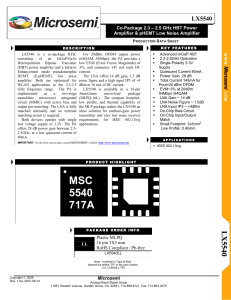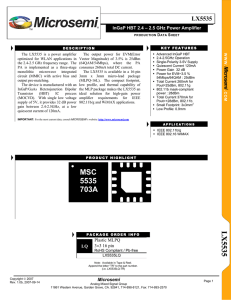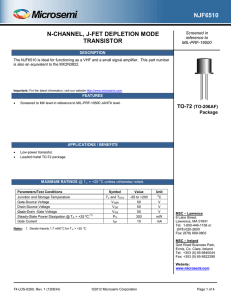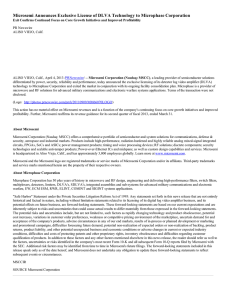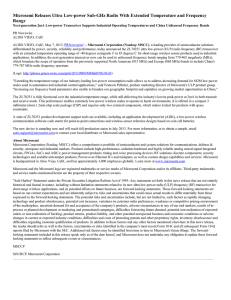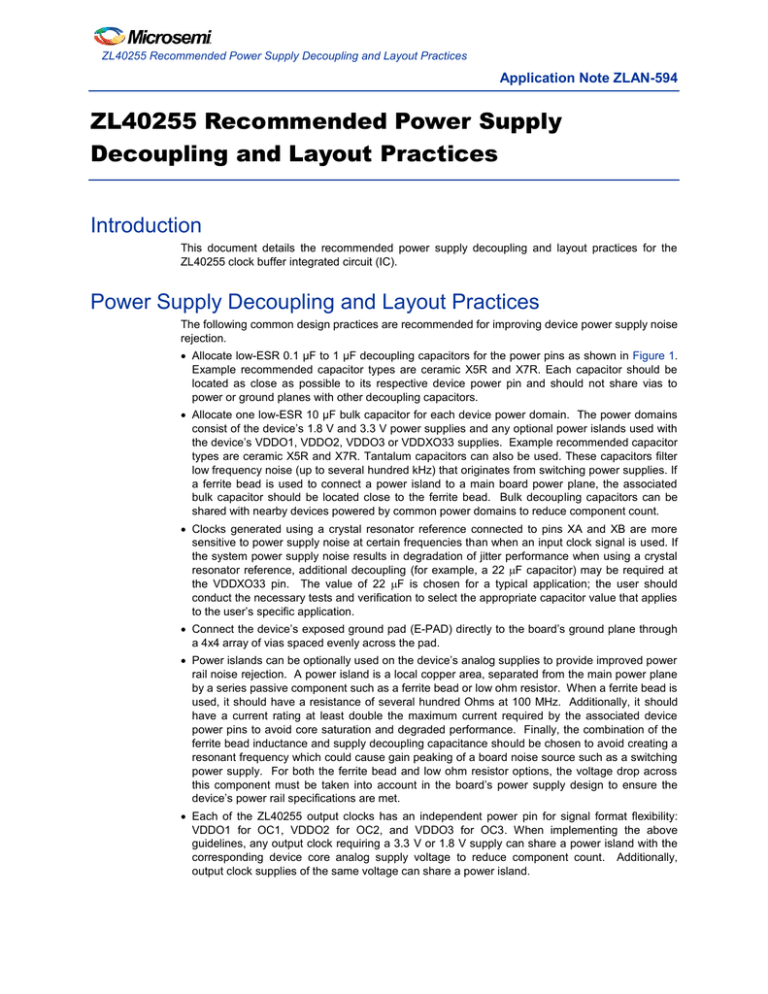
ZL40255 Recommended Power Supply Decoupling and Layout Practices
Application Note ZLAN-594
ZL40255 Recommended Power Supply
Decoupling and Layout Practices
Introduction
This document details the recommended power supply decoupling and layout practices for the
ZL40255 clock buffer integrated circuit (IC).
Power Supply Decoupling and Layout Practices
The following common design practices are recommended for improving device power supply noise
rejection.
Allocate low-ESR 0.1 µF to 1 µF decoupling capacitors for the power pins as shown in Figure 1.
Example recommended capacitor types are ceramic X5R and X7R. Each capacitor should be
located as close as possible to its respective device power pin and should not share vias to
power or ground planes with other decoupling capacitors.
Allocate one low-ESR 10 µF bulk capacitor for each device power domain. The power domains
consist of the device’s 1.8 V and 3.3 V power supplies and any optional power islands used with
the device’s VDDO1, VDDO2, VDDO3 or VDDXO33 supplies. Example recommended capacitor
types are ceramic X5R and X7R. Tantalum capacitors can also be used. These capacitors filter
low frequency noise (up to several hundred kHz) that originates from switching power supplies. If
a ferrite bead is used to connect a power island to a main board power plane, the associated
bulk capacitor should be located close to the ferrite bead. Bulk decoupling capacitors can be
shared with nearby devices powered by common power domains to reduce component count.
Clocks generated using a crystal resonator reference connected to pins XA and XB are more
sensitive to power supply noise at certain frequencies than when an input clock signal is used. If
the system power supply noise results in degradation of jitter performance when using a crystal
resonator reference, additional decoupling (for example, a 22 F capacitor) may be required at
the VDDXO33 pin. The value of 22 F is chosen for a typical application; the user should
conduct the necessary tests and verification to select the appropriate capacitor value that applies
to the user’s specific application.
Connect the device’s exposed ground pad (E-PAD) directly to the board’s ground plane through
a 4x4 array of vias spaced evenly across the pad.
Power islands can be optionally used on the device’s analog supplies to provide improved power
rail noise rejection. A power island is a local copper area, separated from the main power plane
by a series passive component such as a ferrite bead or low ohm resistor. When a ferrite bead is
used, it should have a resistance of several hundred Ohms at 100 MHz. Additionally, it should
have a current rating at least double the maximum current required by the associated device
power pins to avoid core saturation and degraded performance. Finally, the combination of the
ferrite bead inductance and supply decoupling capacitance should be chosen to avoid creating a
resonant frequency which could cause gain peaking of a board noise source such as a switching
power supply. For both the ferrite bead and low ohm resistor options, the voltage drop across
this component must be taken into account in the board’s power supply design to ensure the
device’s power rail specifications are met.
Each of the ZL40255 output clocks has an independent power pin for signal format flexibility:
VDDO1 for OC1, VDDO2 for OC2, and VDDO3 for OC3. When implementing the above
guidelines, any output clock requiring a 3.3 V or 1.8 V supply can share a power island with the
corresponding device core analog supply voltage to reduce component count. Additionally,
output clock supplies of the same voltage can share a power island.
Figure 1 shows the application of these guidelines to a design which has all output clock signals
configured as current-mode logic (CML) which requires a 3.3 V supply.
Figure 1 Example ZL40255 Power Supply Decoupling Scheme
Microsemi Corporation (MSCC) offers a comprehensive portfolio of semiconductor and system
solutions for communications, defense & security, aerospace and industrial markets. Products
include high-performance and radiation-hardened analog mixed-signal integrated circuits,
FPGAs, SoCs and ASICs; power management products; timing and synchronization devices
and precise time solutions, setting the world's standard for time; voice processing devices; RF
solutions; discrete components; security technologies and scalable anti-tamper products;
Ethernet solutions; Power-over-Ethernet ICs and midspans; as well as custom design
capabilities and services. Microsemi is headquartered in Aliso Viejo, Calif., and has
approximately 3,600 employees globally. Learn more at www.microsemi.com.
Microsemi Corporate Headquarters
One Enterprise, Aliso Viejo,
CA 92656 USA
Within the USA: +1 (800) 713-4113
Outside the USA: +1 (949) 380-6100
Sales: +1 (949) 380-6136
Fax: +1 (949) 215-4996
E-mail: sales.support@microsemi.com
© 2016 Microsemi Corporation. All
rights reserved. Microsemi and the
Microsemi logo are trademarks of
Microsemi Corporation. All other
trademarks and service marks are the
property of their respective owners.
Microsemi makes no warranty, representation, or guarantee regarding the information contained herein or
the suitability of its products and services for any particular purpose, nor does Microsemi assume any
liability whatsoever arising out of the application or use of any product or circuit. The products sold
hereunder and any other products sold by Microsemi have been subject to limited testing and should not
be used in conjunction with mission-critical equipment or applications. Any performance specifications are
believed to be reliable but are not verified, and Buyer must conduct and complete all performance and
other testing of the products, alone and together with, or installed in, any end-products. Buyer shall not
rely on any data and performance specifications or parameters provided by Microsemi. It is the Buyer’s
responsibility to independently determine suitability of any products and to test and verify the same. The
information provided by Microsemi hereunder is provided “as is, where is” and with all faults, and the
entire risk associated with such information is entirely with the Buyer. Microsemi does not grant, explicitly
or implicitly, to any party any patent rights, licenses, or any other IP rights, whether with regard to such
information itself or anything described by such information. Information provided in this document is
proprietary to Microsemi, and Microsemi reserves the right to make any changes to the information in this
document or to any products and services at any time without notice.
ZLAN-594/2.16

